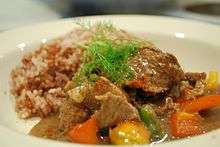Beef Stroganoff
 | |
| Place of origin | Russia |
|---|---|
| Main ingredients | Beef, smetana (sour cream) |
|
| |
Beef Stroganoff or Beef Stroganov (Russian: бефстроганов befstróganov) is a Russian dish of sautéed pieces of beef served in a sauce with smetana (sour cream). From its origins in mid-19th-century Russia, it has become popular around the world, with considerable variation from the original recipe.
Name
Various explanations are given for the name, presumably derived from some member of the large and important Stroganov family, perhaps Alexander Grigorievich Stroganoff of Odessa or a diplomat, Count Pavel Stroganov.[1]
History

Elena Molokhovets's classic Russian cookbook A Gift to Young Housewives gives the first known recipe for Govjadina po-strogonovski, s gorchitseju, "Beef à la Stroganov, with mustard", in its 1871 edition.[2][3][4] The recipe involves lightly floured beef cubes (not strips) sautéed, sauced with prepared mustard and bouillon, and finished with a small amount of sour cream: no onions, no mushrooms. A competition purported to have taken place in 1890 is sometimes mentioned in the dish's history, but both the recipe and the name existed before then. Another recipe, this one from 1909, adds onions and tomato sauce, and serves it with crisp potato straws, which are considered the traditional side dish for Beef Stroganoff in Russia.[2][5] The version given in the 1938 Larousse Gastronomique includes beef strips, and onions, with either mustard or tomato paste optional.

After the fall of Tsarist Russia, the recipe was popularly served in the hotels and restaurants of China before the start of World War II.[6] Russian and Chinese immigrants, as well as US servicemen stationed in pre-Communist China, brought several variants of the dish to the United States, which may account for its popularity during the 1950s. It came to Hong Kong in the late fifties, with Russian restaurants and hotels serving the dish with rice, but not sour cream. In the version often prepared in the United States today in restaurants and hotels, it consists of strips of beef filet with a mushroom, onion, and sour cream sauce, and is served over rice or noodles.

In the UK and Australia, a recipe very similar to that commonly found in the United States has become popular, generally served with rice and sometimes with pasta as well as in commercially prepared frozen dishes.[7] Today, the dish is generally served over twisted egg noodles in the United States. British pubs usually serve a version of the dish with a creamy white wine sauce, whereas more "authentic" versions are often red stews with a scoop of sour cream separately served on top.
Around the world

Larousse Gastronomique lists Stroganov as a cream, paprika, veal stock and white wine recipe.
The Brazilian variant includes diced beef or strips of beef (usually filet mignon) with tomato sauce, onions, mushrooms and heavy whipping cream. Brazilians also prepare Stroganoff with chicken or even shrimp instead of beef. It is commonly served with potato sticks, as in Russia, but with the addition of white rice. Sometimes one can also see creative servings of estrogonofe, such as a crepe filling, a topping for baked potatoes, or on pizzas. Many recipes and variations exist — with or without wine, with canned sweet corn, with ketchup instead of tomato sauce, etc.
Stroganoff is also popular in Nordic countries. In Sweden, a common variant is korv-stroganoff (sausage Stroganoff), which uses the local falukorv sausage as a substitute for the beef. In Finland, the dish is called makkara-stroganoff, makkara meaning any kind of sausage. Beef Stroganoff is, however, also a common dish. Diced brined pickles are also a normal ingredient in Finnish Stroganoff.
Stroganoff's popularity extends to Japan, where it is most commonly served with white rice, or white rice seasoned with parsley and butter. Its popularity increased dramatically with the introduction of "instant sauce cubes" from S&B corporation. These are cubes with dried seasoning and thickening agents that can be added to water, onion, beef, and mushrooms to make a Stroganoff-style sauce. Additionally, Japanese home recipes for Stroganoff frequently call for "non-traditional" Japanese ingredients, such as small amounts of soy sauce.
See also
Notes
- ↑ Oxford Companion to Food, s.v. "beef".
- 1 2 Елена Молоховец. Подарок молодым хозяйкам (in Russian). Санкт-Петербург. A Gift to Young Housewives, English translation: Joyce Stetson Toomre (1998). Classic Russian Cooking: Elena Molokhovets' a Gift to Young Housewives. Indiana University Press. ISBN 9780253212108. First edition of the book by Molokhovets was issued in 1861. Beef Stroganoff first appeared in the 1871 edition, as specified in Volokh, 1983, and Syutkin, 2015. The 1912 recipe mentioned by Toomre is in Alekandrova-Ignatieva, 1912, p. 611, but was also published in earlier editions.
- ↑ Anne Volokh, Mavis Manus,The Art of Russian Cuisine. New York: Macmillan, 1983, p. 266, ISBN 978-0026220903
- ↑ Olga Syutin, Pavel Syutkin, CCCP COOK BOOK: True Stories of Soviet Cuisine. Fuel Publishing, 2015, ISBN 978-0993191114
- ↑ Александрова-Игнатьева, Пелагея Павловна (1909). Практические основы кулинарного искусства. Санкт-Петербург. p. 595. [Pelageya Alexandrova-Ignatieva (1909). The Practical Fundamentals of Cookery Art (in Russian). St. Petersburg.]
- ↑ Frank Dorn, The Dorn Cookbook. Chicago: Henry Regnery Company, 1953, pp. 126-127
- ↑ Lean Cuisine's Beef Stroganoff with Pasta
External links
- The Food Timeline has some quotes about the dish.
- Beef Stroganoff collecting and sharing all known Beef Stroganoff recipes.